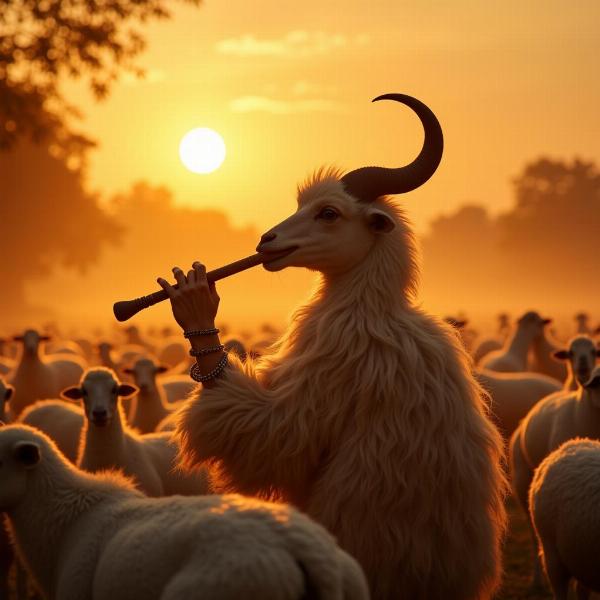The word “charwaha meaning in hindi” often brings to mind the simple image of a shepherd tending his flock. However, the term encompasses a deeper cultural significance, representing a way of life intertwined with nature, tradition, and spirituality. This article delves into the various meanings and connotations of “charwaha,” exploring its relevance in Indian society, literature, and religious contexts.
Understanding the Core Meaning of Charwaha
“Charwaha” (चरवाहा) in Hindi primarily translates to “shepherd” or “herdsman.” It refers to a person who takes care of livestock, typically sheep, goats, or cows. This occupation, deeply rooted in rural India, represents a close connection to the land and its resources. The charwaha’s life is often depicted as one of simplicity and harmony with nature, a stark contrast to the complexities of urban living. Beyond the literal meaning, “charwaha” also carries symbolic weight, often used in literature and poetry to represent a guide, protector, or even a divine figure.
Charwaha in Indian Culture and Literature
The charwaha is a recurring figure in Indian folklore, songs, and literature. From ancient epics to modern-day poetry, the charwaha symbolizes various themes, including pastoral life, divine love, and the relationship between humans and nature. In the Bhagavata Purana, Lord Krishna is often depicted as a divine charwaha, playing his flute and tending to his cows in the idyllic pastures of Vrindavan. This portrayal emphasizes the spiritual connection between humans, nature, and the divine. The charwaha’s flute, often referred to as the “bansuri,” becomes a symbol of divine music, captivating both humans and animals alike.
Charwaha: Beyond the Literal Shepherd
The term “charwaha” is not confined to its literal meaning. It is often used metaphorically to describe someone who guides and protects others. A spiritual leader might be referred to as a “charwaha” guiding his followers towards enlightenment. Similarly, a political leader can be seen as a “charwaha” responsible for the well-being of his people. This metaphorical usage expands the scope of “charwaha” beyond the pastoral context, highlighting its significance in various aspects of Indian life.
 Charwaha Playing Flute
Charwaha Playing Flute
Charwaha and the Concept of Pastoralism
Understanding the meaning of “charwaha” necessitates exploring the concept of pastoralism, a way of life centered around raising and herding livestock. meaning of grazing in hindi plays a crucial role in pastoral communities, as it provides sustenance for both the animals and the people who depend on them. gaucho meaning in hindi offers a fascinating parallel to the Indian charwaha, highlighting the similarities and differences between pastoral practices across cultures.
The Charwaha in Modern India
While the traditional role of the charwaha might be evolving in modern India, its cultural and symbolic significance remains strong. The image of the charwaha continues to evoke a sense of nostalgia for a simpler, more connected way of life. shepherd boy meaning in hindi is often used to depict innocence and purity, reinforcing the idyllic image of pastoral life. shep meaning in hindi reinforces the shepherd’s role as a caretaker and protector. Understanding the hindi meaning of pastoralist provides valuable insights into the broader socio-economic context surrounding the charwaha’s life.
Conclusion: The Enduring Legacy of the Charwaha
The term “charwaha meaning in hindi” encapsulates more than just the occupation of a shepherd. It represents a deep-seated connection to nature, tradition, and spirituality, woven into the fabric of Indian culture. From its literal meaning as a herdsman to its metaphorical use as a guide and protector, the charwaha remains a potent symbol in Indian society.
FAQ
- What is the literal meaning of “charwaha” in Hindi? The literal meaning of “charwaha” is shepherd or herdsman.
- How is “charwaha” used metaphorically? “Charwaha” can metaphorically represent a guide, protector, or leader.
- What is the significance of Lord Krishna being depicted as a charwaha? This portrayal highlights the spiritual connection between humans, nature, and the divine.
- Is the charwaha still relevant in modern India? While the traditional role is evolving, its cultural significance remains strong.
- What is the connection between “charwaha” and pastoralism? “Charwaha” is intrinsically linked to pastoralism, a way of life centered around livestock.
Meaning-Hindi.in specializes in accurate and culturally nuanced Hindi translations across various domains, from business and legal documents to technical manuals and website localization. We also offer specialized services for educational and academic materials, ensuring your content resonates with your target audience. Our expertise in Hindi language and culture ensures precise and impactful communication. Contact us at [email protected] or +91 11-4502-7584 for professional Hindi translation services. Meaning-Hindi.in is your trusted partner for bridging language barriers and connecting with the Indian market.